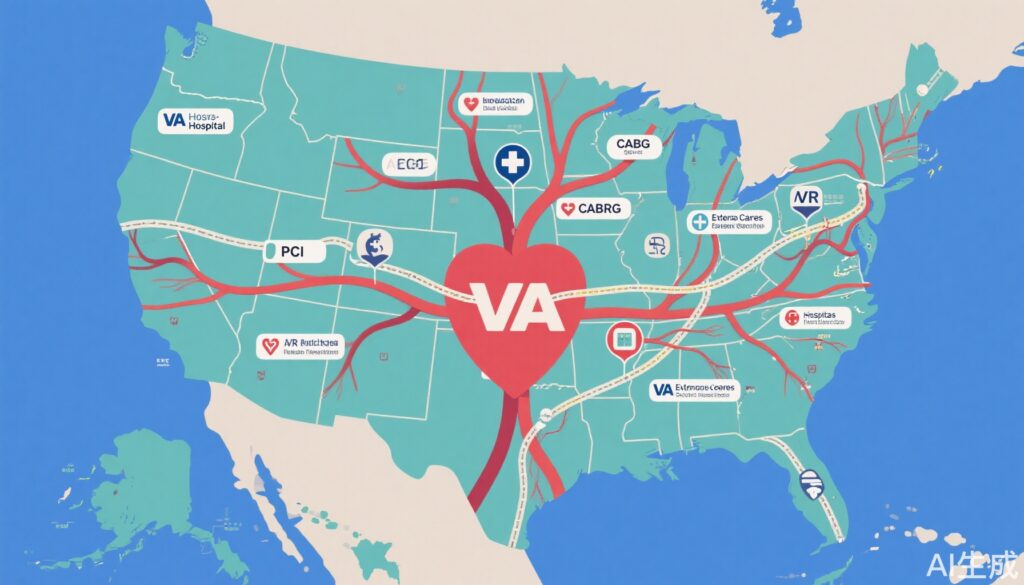Highlights
- The MISSION Act significantly reduced travel times for veterans living far from VA hospitals who required PCI, CABG, or AVR.
- Despite improved access, 30-day major adverse cardiovascular event (MACE) rates increased for PCI and CABG procedures among these veterans.
- No statistically significant difference in short-term adverse outcomes was observed for aortic valve replacement (AVR).
- The findings underscore the complexity of balancing access to care and procedural outcomes in health system reforms.
Clinical Background and Disease Burden
Cardiovascular disease (CVD) remains the leading cause of morbidity and mortality among U.S. veterans, mirroring trends in the general population. Procedures such as percutaneous coronary intervention (PCI), coronary artery bypass grafting (CABG), and aortic valve replacement (AVR) are essential interventions for advanced coronary and valvular heart disease. Historically, most veterans have received these procedures within the Department of Veterans Affairs (VA) health system. However, geographical barriers and the concentration of specialized VA centers have posed significant challenges, especially for those residing far from tertiary care VA hospitals. These access issues contribute to delayed care, increased travel burden, and potentially worse clinical outcomes.
The MISSION Act, enacted in 2018, aimed to address these disparities by allowing veterans greater flexibility to access non-VA healthcare providers, particularly for those living more than 60 minutes from a VA facility. While the legislation promised to improve access, its impact on the quality and safety of high-risk cardiovascular procedures remained uncertain prior to this study.
Research Methodology
This retrospective, difference-in-differences cohort study evaluated the impact of the MISSION Act on travel times and short-term clinical outcomes for veterans undergoing nonemergent or nonurgent PCI, CABG, or AVR. The analysis included veterans treated between October 2016 and September 2022, either in VA hospitals or in non-VA hospitals under MISSION Act coverage, across the 48 contiguous U.S. states and the District of Columbia. Analyses were performed in 2023–2024.
The study population was stratified into two groups: veterans living far from (>60 minutes) the nearest VA medical center (eligible for expanded non-VA care) versus those living near (≤60 minutes) a VA center. The primary outcomes were major adverse cardiovascular events (MACE) within 30 days of the procedure—defined as rehospitalization for a cardiovascular cause or all-cause mortality—and travel times to care.
Key Findings
A total of 43,000 veterans (mean age 69 years, 98% male) underwent PCI, 23,301 (mean age 69 years, 98% male) underwent CABG, and 14,682 (mean age 74 years, 98% male) underwent AVR during the study period.
Travel Times:
– PCI: After MISSION Act implementation, mean travel times decreased by 29.2 minutes for far patients but increased by 1.3 minutes for near patients, yielding a difference-in-differences of -30.5 minutes (P < .001).
– CABG: Mean travel time decreased by 18.1 minutes for far patients and increased by 9.4 minutes for near patients (difference-in-differences, -27.4 minutes; P < .001).
– AVR: Mean travel time decreased by 23.0 minutes for far patients and increased by 10.0 minutes for near patients (difference-in-differences, -33.1 minutes; P < .001).
Major Adverse Cardiovascular Events (MACE):
– PCI: MACE rates increased by 2.3 percentage points for far patients and decreased by 0.5 points for near patients after MISSION Act implementation (difference-in-differences, 2.8 percentage points; P < .001).
– CABG: MACE rates increased by 1.6 points for far patients and decreased by 6.5 points for near patients (difference-in-differences, 8.1 percentage points; P < .001).
– AVR: No statistically significant difference in MACE rates between far and near patients (P = .45).
These findings indicate that while the MISSION Act achieved its goal of reducing travel times for geographically remote veterans, this improvement did not translate into better short-term clinical outcomes for PCI and CABG; in fact, it was associated with an increased risk of adverse events.
Mechanistic Insights and Biological Plausibility
The increased MACE rates among veterans receiving non-VA procedural care may reflect several factors:
– Potential differences in perioperative care coordination between VA and non-VA facilities, including transitions of care and follow-up.
– Variability in the experience of non-VA centers with veteran-specific comorbidities or the unique complexities of the veteran population (e.g., higher rates of mental health disorders, substance use, or multimorbidity).
– Possible differences in adherence to VA-specific clinical pathways, quality metrics, or integrated electronic health record systems, which may impact continuity and safety.
The lack of significant difference in AVR outcomes may be related to the highly specialized and standardized nature of these procedures and the centralization of expertise in both VA and non-VA centers.
Controversies and Limitations
This study is a landmark in evaluating policy-driven changes in healthcare access and quality. Nevertheless, several limitations merit discussion:
– The study’s retrospective, observational design introduces potential for unmeasured confounding.
– The predominantly male, older veteran population may limit generalizability to women and younger patients.
– The analysis was limited to short-term (30-day) outcomes, and longer-term effects remain unmeasured.
– Potential selection bias may exist if sicker or more complex patients were preferentially referred to VA versus non-VA facilities.
– The study did not directly assess process-of-care quality metrics, such as medication adherence or guideline-concordant therapy.
Conclusion
The MISSION Act succeeded in reducing travel barriers for veterans living far from VA centers, but these gains were accompanied by increased short-term adverse cardiovascular events for those undergoing PCI and CABG. These findings highlight the need for rigorous quality oversight and enhanced care coordination as non-VA procedural access expands. Future research should focus on identifying specific care processes associated with these outcome disparities and explore interventions to harmonize quality across VA and non-VA settings.
References
1. Wu J, Kanter GP, Wagner TH, Chu D, Cashy JP, Prigge JM, Glorioso TJ, Rahman N, Murali N, Giri J, Nathan AS, Waldo SW, Groeneveld PW. Impact of the MISSION Act on Quality and Outcomes of Major Cardiovascular Procedures Among Veterans. JAMA. 2025 Jul 31:e2511661. doi: 10.1001/jama.2025.11661.
2. VA Maintaining Internal Systems and Strengthening Integrated Outside Networks (MISSION) Act of 2018. Pub. L. 115-182.
3. Khera R, et al. Association of the Veterans Choice Act With Access to Cardiac Revascularization Procedures and Outcomes Among US Veterans. JAMA Cardiol. 2019;4(4):363–371.
4. Osei AD, et al. Cardiovascular Disease Burden Among US Veterans: A Review. Curr Cardiol Rep. 2020;22(8):71.


